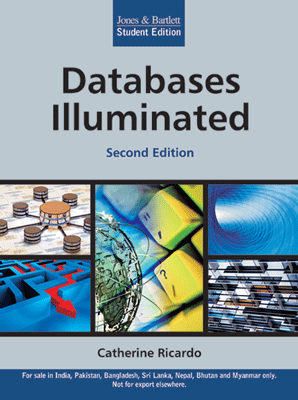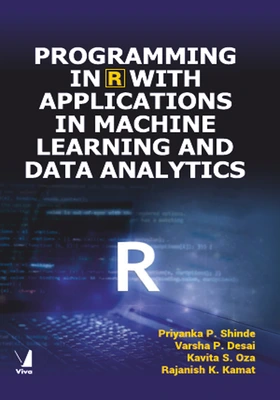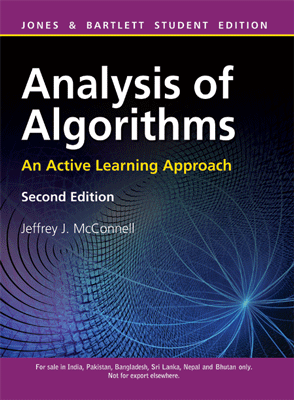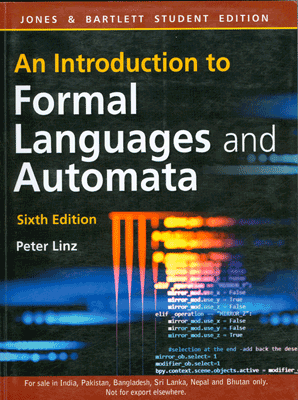Databases Illuminated, 2/e
Databases Illuminated, 2/e
₹535.50 ₹595.00 Save: ₹59.50 (10%)
Go to cartISBN: 9789380853321
Bind: Paperback
Year: 2011
Pages: 688
Size: 7.5 x 9.25 Inch
Publisher: Jones & Bartlett Learning
Published in India by: Jones & Bartlett India
Exclusive Distributors: Viva Books
Sales Territory: India, Nepal, Pakistan, Bangladesh, Sri Lanka
Description:
This updated Second Edition of the popular Databases Illuminated integrates database theory with a practical approach to database design and implementation. The text is specifically designed for the modern database student, who will be expected to know both theory and applied design and implementation as a professional in the field. It covers conceptual material thoroughly, and then shows how concepts are applied to create working databases that illustrate the theory. Students are guided through the stages of database planning and design, beginning with requirements gathering and progressing to conceptual, logical, and physical design. This Second Edition has been revised and updated to incorporate information about the new releases of Microsoft Access 2010, Oracle Database 11g, and InterSystems Cache. It includes material on the most recent topics, such as web access, JDBC, web programming, XML, data mining, and other emerging database technologies and applications.
The integrated, modern approach to databases, combined with strong pedagogical features, accessible writing, and a full package of student and instructor resources, make Databases Illuminated, Second Edition the perfect textbook for courses in this exciting field.
New and Key Features of the Updated Second Edition:
- Provides balanced coverage of theory and applied database design and implementation throughout
- Covers the new features of the current versions of popular database management systems, including Oracle 11g, Access 2010, and InterSystems Cache
- Incorporates the new curriculum recommendations in ACM Computer Science Curriculum 2008 and ACM/AIS IS 2010 Curriculum Guidelines for IS 2010.2, Data and Information Management, including more attention to security, concurrency, and net-centric computing. The chapter on computer ethics has been updated to take into account new regulations and practices
- Concepts are presented and then applied in examples and in the continuing student projects and lab exercises on the website, so students receive hands-on practice with applications
- Includes the extensive object-relational features of the current release of Oracle, with downloadable code for students to implement
- Object-oriented databases are implemented using InterSystems Cache, with downloadable code included on the website
Target Audience:
Students & academicians of computer science, information science, IT professionals, database management professionals.
Contents:
Chapter 1. Introductory Database Concepts • Chapter Objectives • Uses of Databases • A Sample Database • The Integrated Database Environment • Roles in the Integrated Database Environment • Advantages of the Integrated Database Approach • Historical Developments in Information Systems • Chapter Summary • Exercises
Chapter 2. Database Planning and Database Architecture • Chapter Objectives • Data as a Resource • Characteristics of Data • Data and Information • Levels of Discussing Data • Data Sublanguages • Stages in Database Design • Design Tools • Data Dictionary • Project Management Software • Database Administration • Planning and Design • Developing the Database • Database Management • The Three-Level Database Architecture • External Views • Logical and Conceptual Models • Internal Model • Data Independence • Overview of Data Models • The Entity-Relationship Model • Relational Model • Object-Oriented Model • Object-Relational Model • Semistructured Data Model • Chapter Summary • Exercises
Chapter 3. The Entity-Relationship Model • Chapter Objectives • Purpose of the E-R Model • Entities • Attributes • Domains • Null Values • Multivalued Attributes • Composite Attributes • Derived Attributes • Keys • Superkeys • Candidate Keys • Primary Keys • Relationships • Degree of Relationships • Attributes of Relationship Sets • Cardinality of a Relationship • Showing Cardinalities on an E-R Diagram • Participation Constraints • Roles • Existence Dependency and Weak Entities • A Sample E-R Diagram • Chapter Summary • Exercises
Chapter 4. The Relational Model • Chapter Objectives • Advantages of the Relational Model • Relational Data Structures • Tables • Mathematical Relations • Database Relations and Tables • Properties of Relations • Degree and Cardinality • Relation Keys • Integrity Constraints: domain, key, foreign key, general constraints • Representing Relational Database Schemas • Relational Data Manipulation Languages • Categories of DMLs • Relational Algebra • Views • Mapping an E-R Model to a Relational Schema • Chapter Summary • Exercises
Chapter 5. Relational Database Management Systems and SQL • Chapter Objectives • Brief History of SQL in Relational Database Systems • Architecture of a Relational Database Management System • Defining the Database: SQL DDL • CREATE TABLE • CREATE INDEX • ALTER TABLE, RENAME TABLE • DROP Statements • Manipulating the Database: SQL DML • Introduction to the SELECT Statement • SELECT Using Multiple Tables • SELECT with Other Operators • Operators for Updating: UPDATE, INSERT, DELETE • Creating and Using Views • Active Databases • Enabling and Disabling Constraints • SQL Triggers • Using COMMIT and ROLLBACK Statements • SQL Programming • SQL PSMs • Embedded SQL • Dynamic SQL • APls • The System Catalog • Chapter Summary • Exercises
Chapter 6. Normalization • Chapter Objectives • Objectives of Normalization • Insertion, Update, and Deletion Anomalies • Functional Dependency • Superkeys, Candidate Keys, and Primary Keys • Normalization Using Primary Keys • First Normal Form • Full Functional Dependency and Second Normal Form • Transitive Dependency and Third Normal Form • Boyce-Codd Normal Form • Comprehensive Example of Functional Dependencies • Properties of Relational Decompositions • Attribute Preservation • Dependency Preservation • Lossless Decomposition • Decomposition Algorithm for Boyce-Codd Normal Form with • Lossless Join • The Normalization Process • Analysis • Synthesis • Normalization from an Entity-Relationship Diagram • When to Stop Normalizing • Chapter Summary • Exercises
Chapter 7. The Object-Oriented Model • Chapter Objectives • Rationale for the Object-Oriented Data Model • Object-Oriented Data Concepts • Objects and Literals • Classes • Class Hierarchies and Inheritance • Object Identity • Object-Oriented Data Modeling Using UML • The ODMG Model and ODL • Class Declarations • Extent • Attributes • Relationships • Methods • Classes and Inheritance • N-ary Relationships and M:N Relationships with Attributes • Keys • Object Query Language • Developing an 00 Database • Developing an 00 Database in Cache • Chapter Summary • Exercises
Chapter 8. The Enhanced Entity-Relationship Model and the Object-Relational Model • Chapter Objectives • Rationale for Extending the E-R Model • Generalization and Specialization • Specialization • Generalization • Generalization Constraints-Disjointness, Completeness, Definition • Method • Multiple Hierarchies and Inheritance • Union • Using (min,max) Notation for Cardinality and Participation • A Sample EE-R Diagram • Mapping the EE-R Model to a Relational Model • Summary of E-R to Strictly Relational Mapping Concepts • Mapping EE-R Class Hierarchies to Relational Tables • Mapping Unions • Extending the Relational Model • New Fundamental Data Types • Collection Types • User-Defined Data Types (UDT) • Reference Types • Type Hierarchies in Standard SQL • Type Hierarchies in Oracle • Nested Tables in Oracle • Oracle Object Views • Converting an EE-R Diagram to an Object-Relational Database Model • Chapter Summary • Exercises
Chapter 9. Introduction to Database Security • Chapter Objectives • Issues in Database Security • Accidental Security Threats • Deliberate Security Threats • Physical Security and User Authentication • Authorization • Access Control • Using Views for Access Control • Security Logs and Audit Trails • Encryption • SQL Authorization Language • Security in Oracle • The Oracle Enterprise Manager Database Control Facility • Security Control Using SQL *Plus • Object Privileges • System Privileges • Roles • Statistical Database Security • Database Security and the Internet • Proxy Servers • Firewalls • Digital Signatures • Certification Authorities • Chapter Summary • Exercises
Chapter 10. Transaction Management • Chapter Objectives • Properties of Transactions • Need for Concurrency Control • Serializability • Locking • Deadlock • Two-Phase Locking Protocol • Levels of Locking • Timestamping • Basic Timestamping Protocol • Thomas? Write Rule • Multiversion Timestamping • Optimistic Techniques • Need for Recovery • Recovery Techniques • Deferred Update Protocol • Checkpoints • Immediate Update Protocol • Shadow Paging • Overview of ARIES Recovery Algorithm • Transaction Management in Oracle • Chapter Summary • Exercises
Chapter 11. Relational Query Optimization • Chapter Objectives • Query Processing and Query Optimization • Algebraic Techniques for Query Transformation • The Query Tree • An SQL Query and Its Relational Algebra Translation • Performing SELECT Operations Early • Evaluating Conjunctive Conditions • Performing PROJECT Early • Equivalence of Algebraic Operations • Heuristics for Query Optimization • Processing Techniques and Cost Estimation • Cost Factors • Cost of Processing Selects • Processing Joins • Processing Other Operations • Pipelining • Query Optimization in Oracle • Chapter Summary • Exercises
Chapter 12. Distributed Databases • Chapter Objectives • Rationale for Distribution • Architectures for a Distributed Systems • Distributed Processing Using a Centralized Database • Client-Server Systems • Parallel Databases • Distributed Databases • Components of a Distributed Database System • Data Placement • Transparency • Transaction Control for Distributed Databases • Concurrency Control • Recovery • Distributed Query Processing • Steps in Distributed Query Processing • Estimating Data Communications Costs • The Semijoin Operation • Chapter Summary • Exercises
Chapter 13. Databases and the Internet • Chapter Objectives • Introduction • Fundamental Concepts of the Internet and the World Wide Web • Origins of the World Wide Web • Browsers, Links, and URIs • HTTP • HTML • XML • Tiered Architectures • Single-Tier Architecture • Two-Tier Architecture • Three-Tier Architecture • Web Programming with Oracle • PL/SQL Web Toolkit • PL/SQL Server Pages (PSP) • JDBC • The Semi-Structured Data Model • Graphical Representation • XML Parsers • XML Data Manipulation • XML and Relational Databases • XML in Oracle • XML DB • Oracle XML Developer's Kits • Chapter Summary • Exercises
Chapter 14. Social and Ethical Issues • Chapter Objectives • Computerization and Society • Ethical Issues • Ethical Standards for Computing Professionals • Intellectual Property • Definition of Intellectual Property • Legal Protections for Intellectual Property • Intellectual Property Protection for Software • Databases and Privacy Issues • Privacy and Security • Privacy as a Human Right • Human Factors • Human Factors in Software Development • The Human-Database Interface • Usability Testing for Database Applications • Chapter Summary • Exercises
Chapter 15. Data Warehouses and Data Mining • Chapter Objectives • Origins of Data Warehouses • Operational Databases and Data Warehouses • Architecture of a Data Warehouse • Developing a Data Warehouse • Top-Down Method • Bottom-Up Method • Comparison of Methods • Data Models for Data Warehouses • ROLAP and MOLAP • Data Cubes and Hypercubes • Star Schema • Snowflake Schema • Columnar Data • Data Warehouse Queries and SQL • Aggregate Functions • RANK Functions • CUBE and ROLLUP Functions • Analytic Functions • Optimization and Index Techniques • Views and View Materialization • Data Warehouse Vendors • Data Mining • Purpose of Data Mining • Types of Knowledge Discovered • Models and Methods Used • Data Mining Process Model • Regression • Decision Trees • Artificial Neural Networks • Clustering • Genetic Algorithms • Applications of Data Mining • Retailing • Banking and Finance • Manufacturing • Science and Medicine • Homeland Security • Search Engines • Data Mining Software Providers • Chapter Summary • Exercises • Index
About the Author:
Catherine M. Ricardo, PhD-Iona College
Catherine Ricardo received a Ph.D. from Columbia University in 1983. She has been on the Computer Science faculty at Iona College since 1979. She has taught a variety of courses including computer literacy, introductory programming in several languages, data structures, discrete mathematics, educational computing, modeling, and artificial intelligence, but she has concentrated on courses in database systems, which she has taught at both the undergraduate and graduate level for over 25 years. Besides writing textbooks on databases, she has written numerous articles and made presentations at many conferences in the field.







